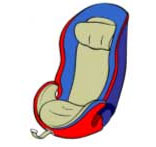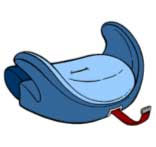Choosing the right child seat
01 Sep 2007|40,773 views
It is against the law for a child below the age of eight to ride in a car without a child car seat. A child can be thrown forward with a sudden jerk, even at a slow speed. The force which acts on the child is many times that of his body weight.
When installed properly, a child car seat ensures that your child is not thrown around in the vehicle during sudden maneuvers. A normal seat belt may not work the way it does for an adult, as a child can easily slip through the seat belt.
Guideline for choosing a child car seat
Some basic points to note
• the belt should be worn as tightly as possible.
• the lap belt should go over the pelvic region, not the stomach.
• the diagonal strap should rest over the shoulder, not the neck.
For babies under 9 Kg
A baby's neck and back muscles are not strong enough to withstand the forces which come about when a baby is thrown forward. His brain may be damaged if his skull not well protected.
Some guidelines are:
It is safer to put children, including babies, in the rear of the car. Some parents prefer to put babies in the front so they can keep an eye on them. However, it is very dangerous to put a rearward-facing baby seat in the front if there is an airbag fitted on the passenger side. The baby seat will be very close to the dashboard. If the airbag is activated, it will strike the baby seat with considerable force.
It is not as dangerous to fit forward-facing seats in the front when there is an airbag present (although it is still better to put them in the rear). However, do make sure that the car seat is pushed as far back as possible. The child seat should be securely held to maximise the distance between the child and the airbag.
When installed properly, a child car seat ensures that your child is not thrown around in the vehicle during sudden maneuvers. A normal seat belt may not work the way it does for an adult, as a child can easily slip through the seat belt.
Guideline for choosing a child car seat
| Age | Weight | Type of Car Seat |
| Babies: up to 9mths | Up to 10kg | Infant capsule rear-facing car seat |
| Toddlers: 9mths - 4 yrs | 10kg - 18kg | Convertible forward-facing child seat |
| Children: 4 yrs - 6 yrs | 15kg - 25kg | Booster seat |
| Children: 6yrs - 8yrs | 22kg - 36kg | Booster cushion |
 | Convertible forward-facing child seat They can be used in the front or in the rear of the car. It is safer to put them in the rear, especially if there is a passenger airbag in the front. Switch to a booster seat when your child has exceeded the maximum weight for the child seat, or if the top of your child's head is higher than the top of the seat. |
 | Booster Seat They can be used in the front or in the rear of the car. It is is safer to put them in the rear, especially if there is a passenger airbag in the front. Some booster seats are designed to be converted into a booster cushion by detaching the back rest. |
 | Booster Cushion They can be used in the front or in the rear of the car. It is safer to put them in the rear, especially if there is a passenger airbag in the front. Booster seats and booster cushions do not have an integral harness to hold the child in place. The adult seat belt goes around the child and the seat. So it is important that the seat belt is correctly adjusted. |
Some basic points to note
• the belt should be worn as tightly as possible.
• the lap belt should go over the pelvic region, not the stomach.
• the diagonal strap should rest over the shoulder, not the neck.
For babies under 9 Kg
A baby's neck and back muscles are not strong enough to withstand the forces which come about when a baby is thrown forward. His brain may be damaged if his skull not well protected.
Some guidelines are:
| • | Have a car seat for your newborn right from the start. |
| • | Always position the seat such that the baby faces the back of the vehicle. |
| • | During a sudden stop, the force is spread evenly across the baby's whole body, pushing the baby against the padded back of the seat. |
It is safer to put children, including babies, in the rear of the car. Some parents prefer to put babies in the front so they can keep an eye on them. However, it is very dangerous to put a rearward-facing baby seat in the front if there is an airbag fitted on the passenger side. The baby seat will be very close to the dashboard. If the airbag is activated, it will strike the baby seat with considerable force.
It is not as dangerous to fit forward-facing seats in the front when there is an airbag present (although it is still better to put them in the rear). However, do make sure that the car seat is pushed as far back as possible. The child seat should be securely held to maximise the distance between the child and the airbag.
| • | Metal fittings on child seats may become very hot if the car is left in direct sunlight. Prevent accidental burns by covering the seat if you have to leave the car in the sun. |
| • | Do not buy second-hand child car seats. They may have invisible defects and will not offer adequate protection for your child. |
| • | Taxi are exempted from the child seat requirement, as it would not be reasonable or practical for them to carry the variety of different-sized child seats suitable for children of different ages. |
It is against the law for a child below the age of eight to ride in a car without a child car seat. A child can be thrown forward with a sudden jerk, even at a slow speed. The force which acts on the child is many times that of his body weight.
When installed properly, a child car seat ensures that your child is not thrown around in the vehicle during sudden maneuvers. A normal seat belt may not work the way it does for an adult, as a child can easily slip through the seat belt.
Guideline for choosing a child car seat
Some basic points to note
• the belt should be worn as tightly as possible.
• the lap belt should go over the pelvic region, not the stomach.
• the diagonal strap should rest over the shoulder, not the neck.
For babies under 9 Kg
A baby's neck and back muscles are not strong enough to withstand the forces which come about when a baby is thrown forward. His brain may be damaged if his skull not well protected.
Some guidelines are:
It is safer to put children, including babies, in the rear of the car. Some parents prefer to put babies in the front so they can keep an eye on them. However, it is very dangerous to put a rearward-facing baby seat in the front if there is an airbag fitted on the passenger side. The baby seat will be very close to the dashboard. If the airbag is activated, it will strike the baby seat with considerable force.
It is not as dangerous to fit forward-facing seats in the front when there is an airbag present (although it is still better to put them in the rear). However, do make sure that the car seat is pushed as far back as possible. The child seat should be securely held to maximise the distance between the child and the airbag.
When installed properly, a child car seat ensures that your child is not thrown around in the vehicle during sudden maneuvers. A normal seat belt may not work the way it does for an adult, as a child can easily slip through the seat belt.
Guideline for choosing a child car seat
| Age | Weight | Type of Car Seat |
| Babies: up to 9mths | Up to 10kg | Infant capsule rear-facing car seat |
| Toddlers: 9mths - 4 yrs | 10kg - 18kg | Convertible forward-facing child seat |
| Children: 4 yrs - 6 yrs | 15kg - 25kg | Booster seat |
| Children: 6yrs - 8yrs | 22kg - 36kg | Booster cushion |
 | Convertible forward-facing child seat They can be used in the front or in the rear of the car. It is safer to put them in the rear, especially if there is a passenger airbag in the front. Switch to a booster seat when your child has exceeded the maximum weight for the child seat, or if the top of your child's head is higher than the top of the seat. |
 | Booster Seat They can be used in the front or in the rear of the car. It is is safer to put them in the rear, especially if there is a passenger airbag in the front. Some booster seats are designed to be converted into a booster cushion by detaching the back rest. |
 | Booster Cushion They can be used in the front or in the rear of the car. It is safer to put them in the rear, especially if there is a passenger airbag in the front. Booster seats and booster cushions do not have an integral harness to hold the child in place. The adult seat belt goes around the child and the seat. So it is important that the seat belt is correctly adjusted. |
Some basic points to note
• the belt should be worn as tightly as possible.
• the lap belt should go over the pelvic region, not the stomach.
• the diagonal strap should rest over the shoulder, not the neck.
For babies under 9 Kg
A baby's neck and back muscles are not strong enough to withstand the forces which come about when a baby is thrown forward. His brain may be damaged if his skull not well protected.
Some guidelines are:
| • | Have a car seat for your newborn right from the start. |
| • | Always position the seat such that the baby faces the back of the vehicle. |
| • | During a sudden stop, the force is spread evenly across the baby's whole body, pushing the baby against the padded back of the seat. |
It is safer to put children, including babies, in the rear of the car. Some parents prefer to put babies in the front so they can keep an eye on them. However, it is very dangerous to put a rearward-facing baby seat in the front if there is an airbag fitted on the passenger side. The baby seat will be very close to the dashboard. If the airbag is activated, it will strike the baby seat with considerable force.
It is not as dangerous to fit forward-facing seats in the front when there is an airbag present (although it is still better to put them in the rear). However, do make sure that the car seat is pushed as far back as possible. The child seat should be securely held to maximise the distance between the child and the airbag.
| • | Metal fittings on child seats may become very hot if the car is left in direct sunlight. Prevent accidental burns by covering the seat if you have to leave the car in the sun. |
| • | Do not buy second-hand child car seats. They may have invisible defects and will not offer adequate protection for your child. |
| • | Taxi are exempted from the child seat requirement, as it would not be reasonable or practical for them to carry the variety of different-sized child seats suitable for children of different ages. |









